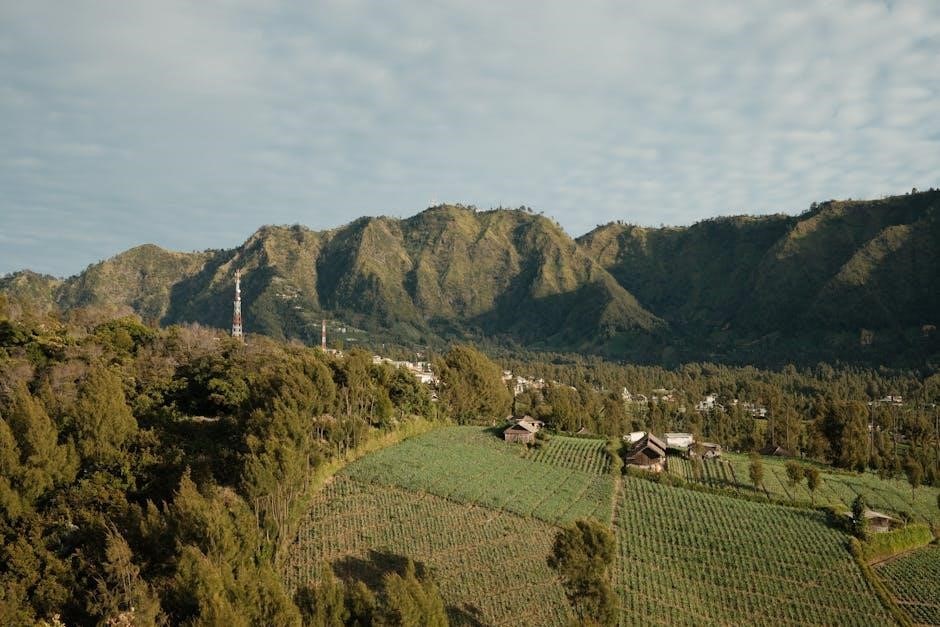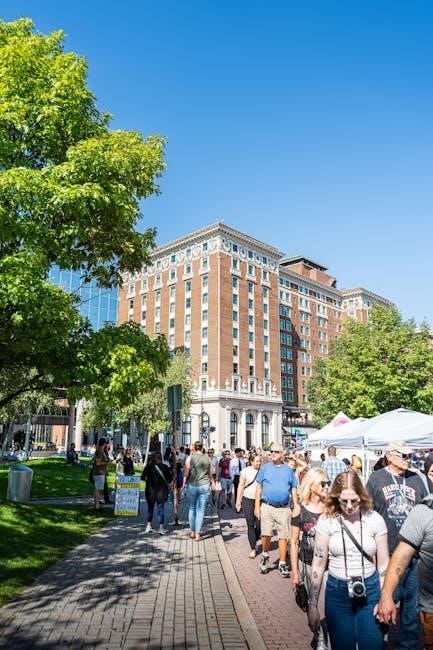Building a custom Minecraft village is an exciting project that combines creativity, planning, and resource management․ It offers access to valuable trades, renewable resources, and a thriving community, while enhancing gameplay with unique designs and defense strategies․
Why Build a Custom Village?
Building a custom village in Minecraft offers unparalleled creativity and control over your world․ Unlike naturally generated villages, a custom design allows you to tailor every aspect to your vision, ensuring a unique and personalized experience․ By constructing from scratch, you can avoid the randomness of NPC village layouts and create a space that perfectly fits your playstyle․ Custom villages also provide a sense of accomplishment and immersion, as you craft a thriving community that feels truly yours․ Whether for aesthetics, functionality, or role-playing, a custom village enhances your Minecraft journey, making it more engaging and rewarding․ It’s a chance to bring your ideas to life in a way that default villages simply can’t match․
Benefits of Having a Custom Village
A custom village in Minecraft offers countless benefits, enhancing both gameplay and creativity․ Unlike naturally generated villages, a custom setup allows for precise control over resources, infrastructure, and layout, ensuring optimal efficiency․ By designing your village from scratch, you can tailor it to your playstyle, whether that’s focusing on trade, defense, or aesthetics․ Custom villages also enable better resource management, as you can strategically place workstations and farms to maximize productivity․ Additionally, they provide a safer environment, as you can design defensive structures to protect against mobs․ A custom village fosters creativity and immersion, making your Minecraft world feel more personalized and vibrant․ It’s a way to showcase your building skills while creating a thriving, self-sufficient community․
Overview of Village Mechanics in Minecraft
Minecraft villages operate on a unique set of mechanics that govern villager behavior, breeding, and interactions․ Villagers have professions tied to specific workstations, influencing their trades and actions․ Breeding villagers requires sufficient food, beds, and a stable environment, with babies growing into adults over time․ Village size impacts gameplay, as larger villages attract more mobs, especially in harder difficulties․ Villages also have defined boundaries, expanding as the population grows․ Trading with villagers unlocks valuable resources, with offerings varying by profession․ Understanding these mechanics is crucial for managing and optimizing your custom village, ensuring it thrives and remains a valuable asset in your Minecraft world․

Choosing the Right Location
Selecting the perfect spot for your village is crucial․ Look for areas with accessible resources, flat terrain, and natural defenses to ensure safety and efficiency․
Best Biomes for Village Construction
When constructing a village, choosing the right biome is essential for resources and aesthetics․ Plains biomes are ideal due to their flat terrain and abundant space․ Savanna biomes offer a stunning view with minimal tree coverage, making construction easier․ Meadow biomes (introduced in newer updates) provide vibrant landscapes and flat areas, perfect for building․ Forest biomes are great for wood supply but may require clearing․ Taiga biomes offer a cozy, wooded environment but may need more preparation․ Avoid biomes like Mushroom Island due to limited space and extreme terrain․ The Nether and End are unsuitable due to their hostile environments․ Select a biome that balances aesthetics, resources, and practicality․
Factors to Consider: Resources and Accessibility
When building a Minecraft village, access to essential resources is crucial․ Ensure proximity to forests for wood, water sources for farming, and flat terrain for ease of construction․ Nearby caves can provide minerals like coal, iron, and diamonds, which are vital for tools and armor․ Accessibility is also key; avoid isolated areas that make travel difficult․ A well-connected village layout enhances efficiency and safety․ Consider the availability of food sources, such as animals or farmland, to sustain villagers․ Proper resource management and accessibility will ensure your village thrives and remains sustainable․ Strategic planning in these areas will greatly enhance your building experience and village success․
Ensuring Flat Terrain for Easy Building
Ensuring flat terrain is crucial for building a functional and visually appealing Minecraft village․ Uneven ground can make construction challenging and affect villager movement․ To flatten the terrain, use a shovel to remove excess dirt, grass, or other blocks․ Digging or filling areas helps create a uniform surface, which is essential for aligning buildings and paths properly․ A flat base also simplifies the layout design, allowing for symmetrical patterns and organized structures․ This ensures villagers can move freely and perform tasks efficiently․ Additionally, flat terrain enhances accessibility and safety, making it easier to build farms, pens, and other essential features․ A well-prepared site is the foundation of a thriving village․

The Essentials of a Minecraft Village
A thriving Minecraft village requires villager housing, workstations for professions, and beds for spawning․ Proper lighting deters mobs, and Iron Golems enhance security․ These elements ensure functionality and safety․
Villager Housing Requirements
Building proper housing for villagers is crucial for their survival and functionality․ Each villager needs a valid house, which includes a bed, a door, and sufficient space․ The house must be fully enclosed to protect against mobs․ The type of material used doesn’t matter, as long as it meets the game’s criteria․ Villagers can claim houses automatically, but ensuring one house per villager is essential for population growth․ Additionally, the number of valid houses determines the village’s maximum population․ To check if a house is valid, villagers will naturally move into it, or you can use a beacon to highlight valid structures․ Proper housing ensures villagers can breed, work, and thrive․
Workstations and Profession Assignment
Workstations are essential for assigning professions to villagers, enabling them to perform specific jobs․ Each profession is tied to a specific workstation, such as a crafting table for craftsmen or a loom for shearers․ To assign a profession, place the corresponding workstation near a villager, and they will claim it as their job․ Villagers can only use workstations that match their profession․ Having multiple workstations increases the variety of trades and services available․ Ensure workstations are accessible and properly placed to maximize efficiency․ This system allows villagers to contribute to the village economy, making your settlement more functional and self-sufficient․
The Importance of Beds in Villages
Beds are a critical component in Minecraft villages, serving multiple essential functions․ They act as spawn points for villagers, ensuring they have a place to rest and regenerate health․ Each bed also helps stabilize the village, preventing mob spawning within its boundaries․ Additionally, beds are required for villager breeding, as they need a place to sleep before producing offspring․ Placing beds in homes ensures villagers can rest, which is vital for their functionality and happiness․ Having enough beds supports population growth, making your village more dynamic and self-sufficient․ Properly placing beds is key to maintaining a thriving, secure, and functional village environment․
Lighting and Its Role in Village Safety
Lighting is a vital aspect of village safety in Minecraft, as it prevents mobs from spawning within the village boundaries․ Properly illuminating key areas, such as streets, homes, and the perimeter, ensures that hostile mobs like zombies and skeletons cannot appear․ Torches, glowstone, and lanterns are effective light sources that can be placed strategically․ Additionally, lighting helps villagers navigate and perform tasks during the night․ Adequate lighting also enhances the visual appeal of the village, making it feel more alive and secure; By ensuring consistent and widespread lighting, you can safeguard your village from potential threats and maintain a peaceful environment for your villagers to thrive․

Acquiring and Breeding Villagers
Villagers can be acquired by finding them in naturally generated villages or by curing zombie villagers․ Breeding requires at least two villagers and ample food․
How to Obtain Your First Villagers
To obtain your first villagers, explore naturally generated villages in various biomes like plains or savannas․ Use specific seeds for closer spawns․ Lead villagers using carrots or potatoes․ Ensure their safety and provide adequate resources and housing to keep them․ Avoid destroying their original village to prevent losing them․ Consider building near their village or relocating them carefully․ Protect them from mobs and ensure a suitable environment for population growth․ Research tutorials or guides for optimal management and leading techniques to effectively establish your village․
Curing Zombie Villagers
To cure a zombie villager, weaken it with a Splash Potion of Weakness․ Then, feed it a Golden Apple․ Ensure the villager is enclosed safely to prevent escape․ The curing process takes several minutes, during which the villager will transform back․ This method restores their trades and functionality․ Curing is cost-effective compared to replacing lost villagers․ Keep the area secure to avoid re-infection․ This process can be repeated for multiple zombie villagers, allowing you to rebuild and expand your village․ Always brew potions and gather resources beforehand for efficiency․ Curing is a valuable skill for maintaining a thriving, healthy village population․
Breeding Mechanics and Population Growth
Villagers breed when there are enough beds and food․ Each villager needs their own bed for breeding․ The population grows as villagers breed, increasing your village’s workforce; Breeding requires 3 bread, 12 potatoes, or 12 carrots per villager․ Babies grow up quickly, becoming adults in minutes․ The more villagers you have, the more trades and services become available․ Breeding is essential for creating a thriving, self-sufficient community․ Ensure ample food and beds to maximize population growth․ New villagers can be assigned professions, enhancing your village’s functionality․ A growing population strengthens your village’s economy and defense capabilities, making it more dynamic and resilient over time․

Designing Your Village Layout
Plan a functional and visually appealing layout․ Balance symmetry with creativity, ensuring space for growth and accessibility․ A well-designed village enhances both aesthetics and functionality, fostering a thriving community․
Principles of Village Layout and Planning
Effective village layout and planning are crucial for functionality and aesthetics․ Start by designating a central hub for essential buildings like the town hall or market․ Organize structures into zones, such as residential, agricultural, and industrial areas, to maintain order․ Ensure pathways are wide and well-connected for easy navigation․ Consider scalability, leaving space for future expansions as your village grows․ Symmetry and alignment can create a visually pleasing environment, while irregular designs add charm․ Balance practicality with creativity, ensuring accessibility to resources and workstations․ A well-planned layout fosters efficiency, happiness, and safety for your villagers, making your village thrive․
- Centralize essential buildings for easy access․
- Zoning helps maintain organization and functionality․
- Pathways should be clear and interconnected․
- Scalability allows for future growth and additions․
- Symmetry or irregular designs can enhance visual appeal․
Adding Variation in Building Heights
Varying building heights adds visual interest and depth to your Minecraft village․ Taller structures like towers or town halls can serve as landmarks, while shorter buildings create cozy, intimate spaces․ Mixing heights ensures the village doesn’t feel flat or monotonous․ Use stairs, bridges, or balconies to connect different levels seamlessly․ Elevated platforms can house markets or observation decks, enhancing functionality․ Experiment with layers to create a dynamic skyline, making your village more engaging and unique․ Balancing heights with thoughtful design ensures a cohesive yet varied aesthetic․

Creating a Themed Village
A themed village adds personality and uniqueness to your Minecraft world․ Choose a theme, such as medieval, modern, or fantasy, and design buildings and decor to match․ Use specific materials like cobblestone for a rustic look or glass for a futuristic vibe․ Add themed elements like torches, banners, or specific mobs to enhance the atmosphere․ Consistency is key; stick to a color scheme and architectural style․ Landmarks like castles, lighthouses, or clock towers can define the theme․ Decorate with plants, furniture, and accessories that fit the era or style․ This approach makes your village stand out and tells a story․
- Choose a theme that inspires you, like medieval or nautical․
- Use materials and colors that align with your theme․
- Add themed decor like banners, torches, or specific furniture․
- Incorporate landmarks that define the theme․
- Stay consistent in design for a cohesive look․

Securing Your Village
Protect your village from mobs by ensuring proper lighting, fencing, and iron golem patrols․ Secure borders with walls or natural barriers to prevent invasions and keep villagers safe․
Protecting Against Monsters and Mobs
Protecting your village from monsters and mobs is crucial for its survival․ Start by ensuring all buildings are well-lit, as darkness attracts mobs․ Use torches, glowstones, or lanterns to illuminate streets and homes․ Surround the village with sturdy fences or walls made of materials like cobblestone or obsidian to prevent mob entry․ Consider adding layers of defense, such as moats filled with water or lava, to deter unwanted visitors․ Iron golems can also be placed strategically to patrol and defend the area․ Regularly check for any gaps or weaknesses in your defenses and reinforce them; A well-secured village ensures your villagers remain safe and thriving․

Using Iron Golems for Defense
Iron golems are powerful allies in defending your Minecraft village․ Crafted using four iron blocks and a pumpkin or jack-o’-lantern, they automatically patrol and protect villagers․ Place them near village entrances or strategic points to maximize their effectiveness․ Each golem can attack hostile mobs within its range, providing constant security․ Ensure there are enough golems for your village size, as they spawn naturally if the population is large enough․ Be aware that golems can occasionally attack villagers if provoked, so position them carefully․ They are also immune to most mob attacks, making them ideal guardians․ Use iron golems to bolster your village’s defense and keep mobs at bay․
Securing the Perimeter with Walls and Fences
Securing your village perimeter with walls and fences is crucial for preventing mob invasions and wandering monsters․ Use durable materials like cobblestone, stone bricks, or obsidian for the walls to ensure strength․ Fences made of wood or nether brick can complement the design while maintaining security․ Build walls at least three blocks high to prevent mobs from climbing over․ Add gates with fences or iron doors for controlled access․ Consider adding a moat filled with lava or water for an extra layer of defense․ Use scaffolding or platforms for archers to patrol the perimeter․ Ensure the perimeter is well-lit to deter mobs from spawning nearby, creating a safe and protected environment for your villagers․ This design enhances both functionality and aesthetics, making your village secure and visually appealing․

Advanced Tips for Village Building
Optimize layouts, automate tasks with redstone, and integrate unique biome features to create a thriving, high-efficiency village that stands out in design and functionality․
Building Trading Halls for Efficiency
Constructing a trading hall centralizes commerce, streamlining villager trades and improving accessibility․ Design a spacious interior with stalls or platforms for each profession, ensuring easy navigation․ Use redstone to automate doors or lighting for enhanced functionality․ Position the hall near the village center to maximize traffic and convenience․ This setup reduces the time spent searching for specific traders and encourages villager breeding․ Decorative elements like banners or torches can add charm without compromising efficiency․ A well-designed trading hall becomes the heart of your village’s economy, balancing practicality and aesthetics for a thriving community․
Using Mods to Enhance Village Management
Mods can significantly enhance village management by adding new features and improving existing mechanics․ Popular mods like Village Tweaks or Minecraft Comes Alive allow for better control over villager behaviors, professions, and relationships․ These mods introduce automated tasks, such as assigning jobs or managing resources more efficiently․ Some mods even add new building types or decorative options, enriching the village aesthetic․ They can also improve villager AI, making them more interactive and responsive․ While mods can add complexity, they offer unparalleled customization for a unique village experience․
Future Updates and Village Mechanics
Minecraft regularly updates with new features that enhance village-building experiences․ Future updates may introduce more complex villager behaviors, expanded profession options, and improved village structures․ Mojang has hinted at adding new biomes and blocks that could revolutionize village design․ Players can expect better AI for villagers, making them more interactive and realistic․ Upcoming updates might also include new village-related achievements and game mechanics․ Staying updated with the latest Minecraft patches ensures access to cutting-edge features for creating unique and immersive villages․ These changes will continue to evolve the game, offering endless possibilities for builders and enthusiasts alike․

Adding Details for a Lived-In Feel
Add decorative elements like flowers, furniture, and small details to make your village feel alive․ These touches enhance realism and charm, creating a cozy atmosphere․
Incorporating Decorative Elements
Decorative elements like flowers, banners, and intricate block designs can elevate your village’s charm․ Use cobblestone or oak plank patterns for pathways, and add lanterns for warm lighting․ Incorporate small details such as fences, bridges, or water features to create a lived-in feel․ Consider adding seasonal decorations, like pumpkins or wreaths, for themed villages․ These elements not only enhance aesthetics but also make the space feel more dynamic and inviting․ By combining these details thoughtfully, you can craft a village that feels vibrant and full of character, making it a standout creation in your Minecraft world․
Adding Animals and Livestock
Adding animals like cows, chickens, and sheep brings life and functionality to your village․ These mobs can provide resources such as food, wool, and leather, making your village more self-sufficient․ Build pens or enclosures to keep them safe and organized․ Place water and food sources nearby to ensure their health․ Adding animals also enhances the village’s ambiance, creating a more immersive experience․ Consider including horses for transportation or llamas for carrying items․ By integrating livestock thoughtfully, you can create a thriving, interactive ecosystem that adds depth and utility to your custom Minecraft village, making it feel more alive and dynamic․
Creating Infrastructure Details
Adding infrastructure details like paths, lighting, and water sources enhances your village’s functionality and charm․ Use materials such as cobblestone, stone slabs, or planks to create pathways for villagers to navigate․ Install torches or lanterns along these paths to provide light and improve visibility․ Consider adding wells, fountains, or canals to incorporate water features, which can also serve as decorative elements․ Additionally, build storage areas or sheds for tools and resources, ensuring everything has its place․ These small touches make your village feel more lived-in and organized, while also improving gameplay mechanics like villager movement and resource accessibility․
Building a custom Minecraft village offers endless creativity and satisfaction․ With proper planning, resources, and attention to detail, your village can thrive and evolve over time․
Final Tips for a Successful Village
Plan meticulously, start small, and expand gradually․ Add decorative details like flowers, torches, and pathways for charm․ Ensure adequate lighting and clear mob-proof paths․ Stay flexible, as Minecraft’s dynamic world often requires adjustments․ Regularly check villager needs, such as beds and workstations․ Experiment with designs and adapt to terrain challenges․ Keep resources stocked and accessible․ Test village mechanics to ensure functionality․ Iterate and improve based on villager behavior and mob interactions․ Building a thriving village is a journey, so embrace creativity and patience․ With these tips, your custom village will become a vibrant, unique hub in your Minecraft world․
The Rewards of Building a Custom Village
Building a custom village in Minecraft offers immense creative fulfillment and practical benefits․ It provides a centralized hub for resources, trading, and crafting, enhancing gameplay efficiency․ A well-designed village fosters a sense of community and accomplishment, as you watch your villagers thrive and grow․ The ability to tailor every aspect to your playstyle adds depth and personalization․ Witnessing your vision come to life and seeing villagers interact with their surroundings is deeply rewarding․ It also encourages creativity, problem-solving, and long-term engagement․ A successful village becomes a testament to your skills and dedication, offering lasting enjoyment and a unique experience in your Minecraft world․
Encouragement to Start Building
Embarking on building a custom Minecraft village is a journey filled with creativity and excitement․ Every block you place and every decision you make brings your vision to life․ Starting small and growing your village overtime allows you to experiment and refine your ideas․ The process is deeply rewarding, as you witness your villagers thrive and your community expand․ Don’t hesitate to explore different designs and themes—each choice reflects your unique style․ With endless possibilities and constant updates to Minecraft, your village can evolve and improve over time; Take the first step, gather your materials, and let your imagination guide you to create something truly extraordinary․
